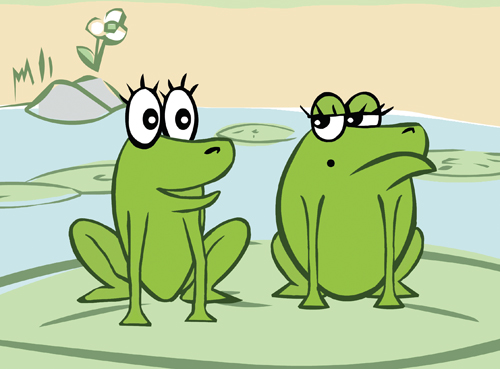
Summary

This classic fable from Russia tells the story of two frog sisters with completely different personalities. One frog is known for being adventurous and impulsive, while the other one is lazy and cautious. A Tale of Two Frogs, written by Martha Hamilton and Mitch Weiss, tells the story of how the two frog sisters literally get in over their heads when they fall into a pail of milk and are trapped. They fall into a precarious predicament and must find a way to save themselves. The lazy and cautious frog practically gives up right away while the adventurous and impulsive frog never gives up. In the end they manage to put their noodles together and persevere.
Analysis
This is the same award-winning creative team who brought you Ghost Catchers and Noodlehead Stories. A Tale of Two Frogs is a folktale that provides valuable life lessons in character values in taking responsibility and being resourceful against all odds. Those that never give up often find themselves handsomely rewarded for their persistence. In the end the lazy frog develops a greater appreciation and newfound respect for her sister's always positive, "it's-not-over-till-it's-over" outlook on life.
Illustrations


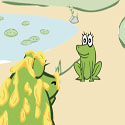
Questions
If you have any questions or comments about A Tale of Two Frogs lesson plans, activities, videos, or any of the other services provided through the Story Cove subscription, please email us at:
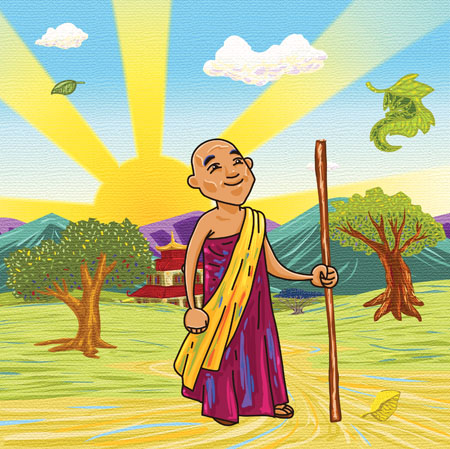
Summary

The Cleverest Thief is a timeless folktale from India, retold by T. V. Padma, which takes place in a Buddhist monastery. In the story, the head of the monastery falls ill and must choose a successor. To do so, he sends out the young monks and instructs them to steal something, but they must steal it in such a way that no one will know that they have stolen it. The young monks don’t question their leader. In the end, only one monk learns the truth of the saying, “To thine own self be true.”
Analysis
This clever story illustrates a number of valuable life lessons, such as taking responsibility for our actions and how to be resourceful in order to meet an overwhelming challenge while earning the trust of those around us. The Buddhist monks learn the value of taking responsibility and earning trust.
Illustrations


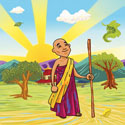
Questions
If you have any questions about The Cleverest Thief lesson plans, activities, or anything else on Story Cove site, please do not hesitate to contact us at:
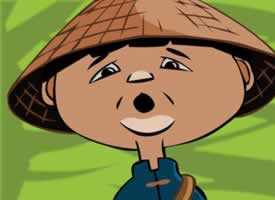
Summary

Interest Level: Ages 4-8
Guided Reading Level:
J
Lexile Level:
640L
Book ISBN:
978-0-874838-27-5
The Magic Pot is a folktale from China about a hardworking woodcutter and his wife. The story, retold by Pleasant DeSpain, describes how the poor woodcutter stumbles upon a magic pot lying by the side of the road. It's a beautiful pot that could be useful for the woodcutter so he places his axe inside the pot and then straps it on his back to take home from the forest. When he arrives home, his wife discovers that the magic pot can duplicate anything placed inside it and they become overwhelmed with joy over their good fortune.
Analysis
When the poor woodcutter discovers the magic of the pot he thinks that all of his troubles are over. But he and his wife soon find that their troubles are just beginning and if he is going to survive his new found good fortune he has to act quickly. The Magic Pot is an amusing tale that provides valuable life lessons in character values. These practical character values include caring for others, sharing, and being resourceful while also exercising good citizenship in the community.
Illustrations
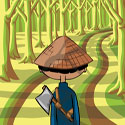


Questions
If you have any questions about The Magic Pot, the lesson plans, or activities, please email us at:

Summary

This timeless story from India is about a poor boy's dream of having his own drum. His mother is very poor and cannot afford to buy her son the one thing in the world that he really wants. The poor boy's dream takes him on one of the most unlikely journeys and ultimately leads to attaining his dream. The folktale begins with his mother bringing home a magical stick that was given to her by a strange, little old man. The boy takes the stick with him on his journey and along the way he finds people in need of help. He offers them what little he has and they of course repay him with whatever they have in return. By the end of the story, his series of good deeds leads him to a traditional wedding ceremony where he saves the wedding day for the bride and groom when he presents them with a horse. In return, for his good deed, he receives a drum like the one he was dreaming of at the beginning of the story.
Analysis
Rob Cleveland adapts this traditional story from India to show how a poor, young boy’s generosity to share his good fortune can eventually lead to unexpected happiness. This folktale provides valuable life lessons in character values about taking responsibility, sharing with others, and caring about other people. The boy is genuinely grateful for what little he has and he continues to make sacrifices and share his belongings to help others. Throughout the story, he consistently places the needs of others before his own desires and in the end his good deeds bring him his own good fortune. This lesson in generosity, caring for other people, and sharing our good fortune with those around us has universal appeal, so it can be understood and celebrated by any culture.
Illustrations
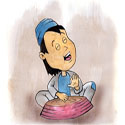


Questions
If you have any questions about The Drum, the lesson plans, animations, activities, or any of the other services offered through the Story Cove subscription, please email us at

Summary

The Archer and the Sun is an ancient story from China. It tells the legend of a time when there were many suns in the sky and it was miserably hot. The people got together to come up with a solution to make their living conditions more hospitable. They decided to call upon the best archer in the land to come and shoot down all of the suns except for one. As a result, the remaining sun naturally became afraid of the archer and hid behind a mountain, leaving the world cold and dark. Then the people had to devise a plan to get the sun to come back from hiding and after several failed attempts, they found a solution.
Analysis
Retold by Rob Cleveland, The Archer and the Sun helps explain why the sun comes up in the morning and goes down at night. This timeless tale from the Chinese oral tradition provides valuable life lessons about sharing and how to be resourceful in challenging situations. We also learn why a certain farm animal is always there to greet the sun every morning when it rises.
Illustrations

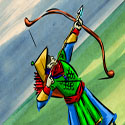
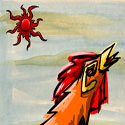
Questions
Have questions about The Archer and the Sun book, the lesson plans and activities, or how to use them with the Common Core Standards? Please email us at:

